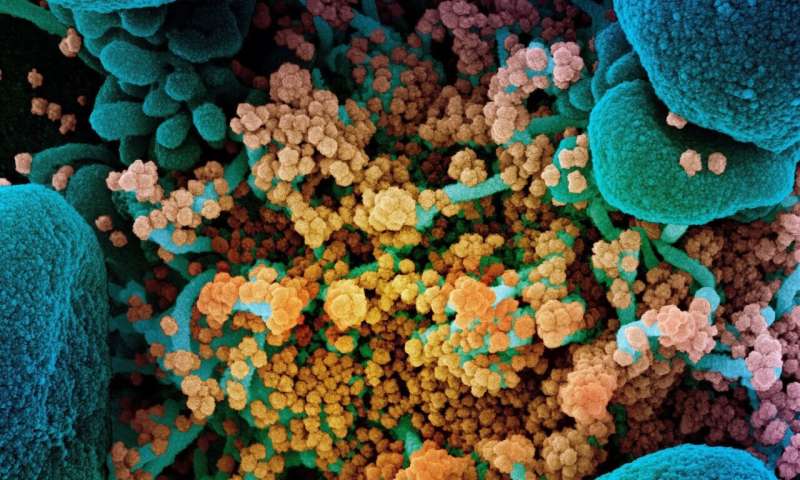COVID-19 severity affected by proportion of antibodies targeting crucial viral protein

COVID-19 antibodies preferentially target a different part of the virus in mild cases of COVID-19 than they do in severe cases, and wane significantly within several months of infection, according to a new study by researchers at Stanford Medicine.
The findings identify new links between the course of the disease and a patient’s immune response. They also raise concerns about whether people can be re-infected, whether antibody tests to detect prior infection may underestimate the breadth of the pandemic and whether vaccinations may need to be repeated at regular intervals to maintain a protective immune response.
“This is one of the most comprehensive studies to date of the antibody immune response to SARS-CoV-2 in people across the entire spectrum of disease severity, from asymptomatic to fatal,” said Scott Boyd, MD, Ph.D., associate professor of pathology. “We assessed multiple time points and sample types, and also analyzed levels of viral RNA in patient nasopharyngeal swabs and blood samples. It’s one of the first big-picture looks at this illness.”
The study found that people with severe COVID-19 have low proportions of antibodies targeting the spike protein used by the virus to enter human cells compared with the number of antibodies targeting proteins of the virus’s inner shell.
Boyd is a senior author of the study, which was published Dec. 7 in Science Immunology. Other senior authors are Benjamin Pinsky, MD, Ph.D., associate professor of pathology, and Peter Kim, Ph.D., the Virginia and D. K. Ludwig Professor of Biochemistry. The lead authors are research scientist Katharina Röltgen, Ph.D.; postdoctoral scholars Abigail Powell, Ph.D., and Oliver Wirz, Ph.D.; and clinical instructor Bryan Stevens, MD.
Virus binds to ACE2 receptor
The researchers studied 254 people with asymptomatic, mild or severe COVID-19 who were identified either through routine testing or occupational health screening at Stanford Health Care or who came to a Stanford Health Care clinic with symptoms of COVID-19. Of the people with symptoms, 25 were treated as outpatients, 42 were hospitalized outside the intensive care unit and 37 were treated in the intensive care unit. Twenty-five people in the study died of the disease.
SARS-CoV-2 binds to human cells via a structure on its surface called the spike protein. This protein binds to a receptor on human cells called ACE2. The binding allows the virus to enter and infect the cell. Once inside, the virus sheds its outer coat to reveal an inner shell encasing its genetic material. Soon, the virus co-opts the cell’s protein-making machinery to churn out more viral particles, which are then released to infect other cells.
Antibodies that recognize and bind to the spike protein block its ability to bind to ACE2, preventing the virus from infecting the cells, whereas antibodies that recognize other viral components are unlikely to prevent viral spread. Current vaccine candidates use portions of the spike protein to stimulate an immune response.
Boyd and his colleagues analyzed the levels of three types of antibodies—IgG, IgM and IgA—and the proportions that targeted the viral spike protein or the virus’s inner shell as the disease progressed and patients either recovered or grew sicker. They also measured the levels of viral genetic material in nasopharyngeal samples and blood from the patients. Finally, they assessed the effectiveness of the antibodies in preventing the spike protein from binding to ACE2 in a laboratory dish.
“Although previous studies have assessed the overall antibody response to infection, we compared the viral proteins targeted by these antibodies,” Boyd said. “We found that the severity of the illness correlates with the ratio of antibodies recognizing domains of the spike protein compared with other nonprotective viral targets. Those people with mild illness tended to have a higher proportion of anti-spike antibodies, and those who died from their disease had more antibodies that recognized other parts of the virus.”
Substantial variability in immune response
The researchers caution, however, that although the study identified trends among a group of patients, there is still substantial variability in the immune response mounted by individual patients, particularly those with severe disease.
“Antibody responses are not likely to be the sole determinant of someone’s outcome,” Boyd said. “Among people with severe disease, some die and some recover. Some of these patients mount a vigorous immune response, and others have a more moderate response. So, there are a lot of other things going on. There are also other branches of the immune system involved. It’s important to note that our results identify correlations but don’t prove causation.”
As in other studies, the researchers found that people with asymptomatic and mild illness had lower levels of antibodies overall than did those with severe disease. After recovery, the levels of IgM and IgA decreased steadily to low or undetectable levels in most patients over a period of about one to four months after symptom onset or estimated infection date, and IgG levels dropped significantly.
“This is quite consistent with what has been seen with other coronaviruses that regularly circulate in our communities to cause the common cold,” Boyd said. “It’s not uncommon for someone to get re-infected within a year or sometimes sooner. It remains to be seen whether the immune response to SARS-CoV-2 vaccination is stronger, or persists longer, than that caused by natural infection. It’s quite possible it could be better. But there are a lot of questions that still need to be answered.”
Boyd is a co-chair of the National Cancer Institute’s SeroNet Serological Sciences Network, one of the nation’s largest coordinated research efforts to study the immune response to COVID-19. He is the principal investigator of Center of Excellence in SeroNet at Stanford, which is tackling critical questions about the mechanisms and duration of immunity to SARS-CoV-2.
Source: Read Full Article



